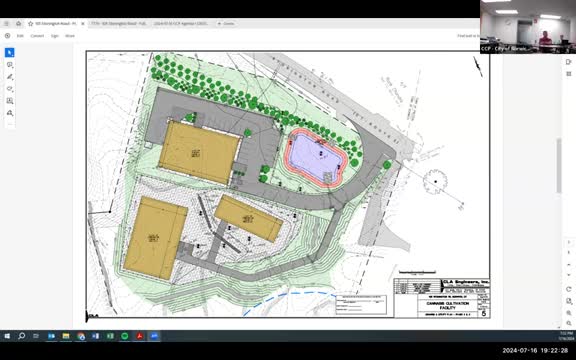Community Divided Over Controversial Cannabis Facility Proposal
July 19, 2024 | Norwich, New London County, Connecticut

This article was created by AI summarizing key points discussed. AI makes mistakes, so for full details and context, please refer to the video of the full meeting. Please report any errors so we can fix them. Report an error »

During a recent government meeting, local officials and residents gathered to discuss a proposed cannabis cultivation and manufacturing facility at 105 Stone Road, raising significant concerns about the project's implications for the surrounding community.
Jerry Grabarek, a dairy farmer and selectman from Preston, initiated the discussion by questioning discrepancies in property size listed in the application. While the assessors' map indicates 7.7 acres, the application states it will cover only 6.04 acres. Officials clarified that the site is being divided, with Nautilus acquiring a portion of the land.
Grabarek expressed skepticism about the suitability of the land for the proposed facility, citing its rocky terrain and shallow bedrock, which he argued would not support a septic system. He suggested connecting to the municipal sewer system instead. Officials responded that the health department had approved the septic system's location after conducting test pits on-site.
The discussion also highlighted concerns about environmental impacts, particularly regarding pesticide use and odor control. Grabarek criticized the applicant's proposed odor management plan, which included planting lavender and other herbs, arguing that these would not provide year-round effectiveness. He urged the planning commission to conduct a site walk before making a decision, emphasizing the need for thorough evaluation given the site's challenging landscape.
Additionally, the Preston Planning and Zoning Commission submitted a letter expressing concerns about the project's alignment with local development goals, particularly regarding the aesthetic impact of a proposed metal industrial building. They noted that the construction could detract from efforts to enhance the Route 2 corridor's appearance, which is vital for local tourism.
In response, Nautilus representatives assured that adjustments had been made to the building's placement and landscaping to mitigate visual impact. They also highlighted their commitment to community engagement through a social equity plan, which includes partnerships with local organizations.
As the meeting concluded, the planning commission faced pressure to balance economic development with community concerns, underscoring the complexities of integrating new industries into established neighborhoods. The outcome of this proposal remains uncertain as further discussions and evaluations are anticipated.
Jerry Grabarek, a dairy farmer and selectman from Preston, initiated the discussion by questioning discrepancies in property size listed in the application. While the assessors' map indicates 7.7 acres, the application states it will cover only 6.04 acres. Officials clarified that the site is being divided, with Nautilus acquiring a portion of the land.
Grabarek expressed skepticism about the suitability of the land for the proposed facility, citing its rocky terrain and shallow bedrock, which he argued would not support a septic system. He suggested connecting to the municipal sewer system instead. Officials responded that the health department had approved the septic system's location after conducting test pits on-site.
The discussion also highlighted concerns about environmental impacts, particularly regarding pesticide use and odor control. Grabarek criticized the applicant's proposed odor management plan, which included planting lavender and other herbs, arguing that these would not provide year-round effectiveness. He urged the planning commission to conduct a site walk before making a decision, emphasizing the need for thorough evaluation given the site's challenging landscape.
Additionally, the Preston Planning and Zoning Commission submitted a letter expressing concerns about the project's alignment with local development goals, particularly regarding the aesthetic impact of a proposed metal industrial building. They noted that the construction could detract from efforts to enhance the Route 2 corridor's appearance, which is vital for local tourism.
In response, Nautilus representatives assured that adjustments had been made to the building's placement and landscaping to mitigate visual impact. They also highlighted their commitment to community engagement through a social equity plan, which includes partnerships with local organizations.
As the meeting concluded, the planning commission faced pressure to balance economic development with community concerns, underscoring the complexities of integrating new industries into established neighborhoods. The outcome of this proposal remains uncertain as further discussions and evaluations are anticipated.
View full meeting
This article is based on a recent meeting—watch the full video and explore the complete transcript for deeper insights into the discussion.
View full meeting
